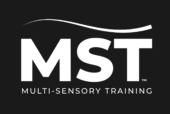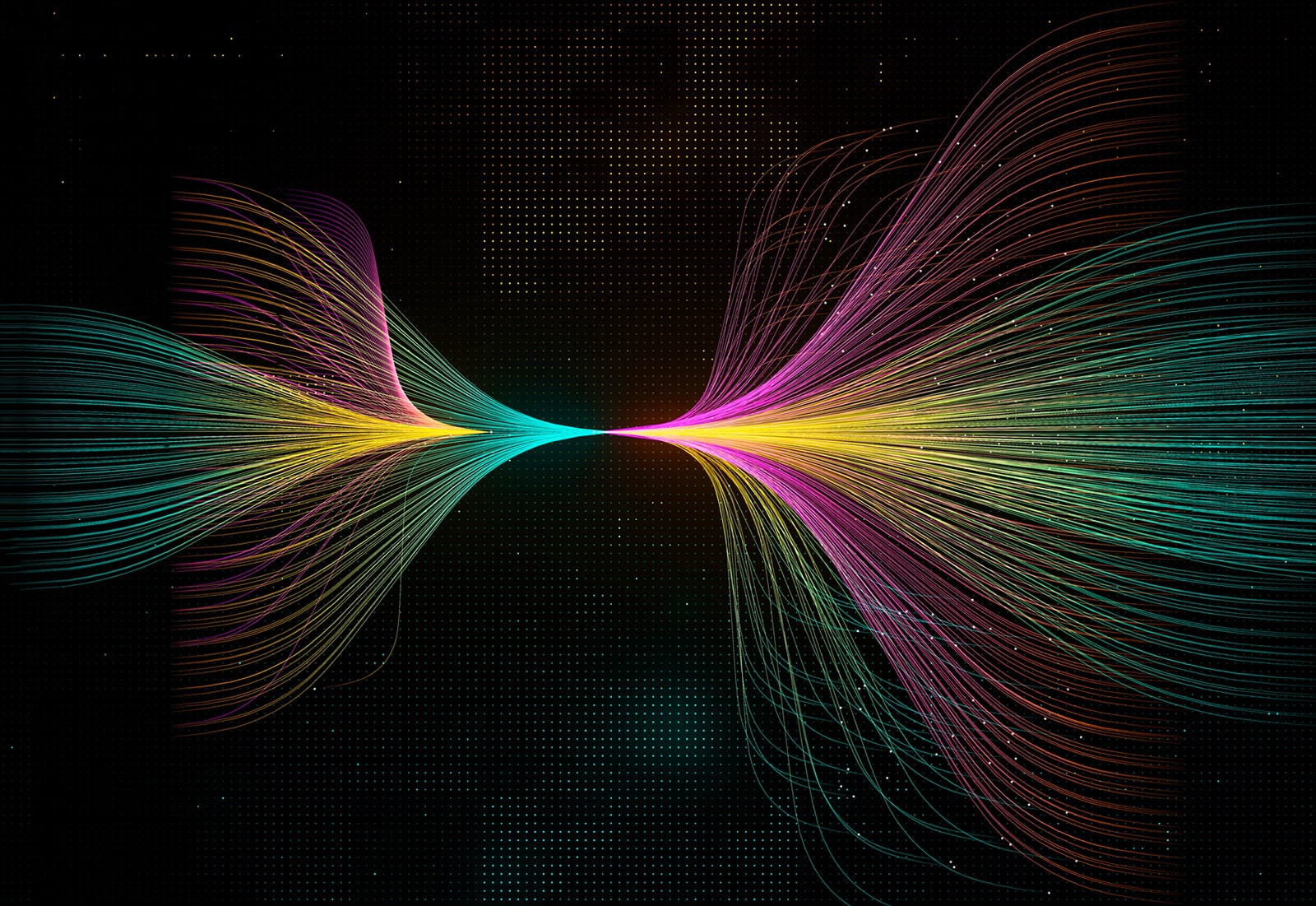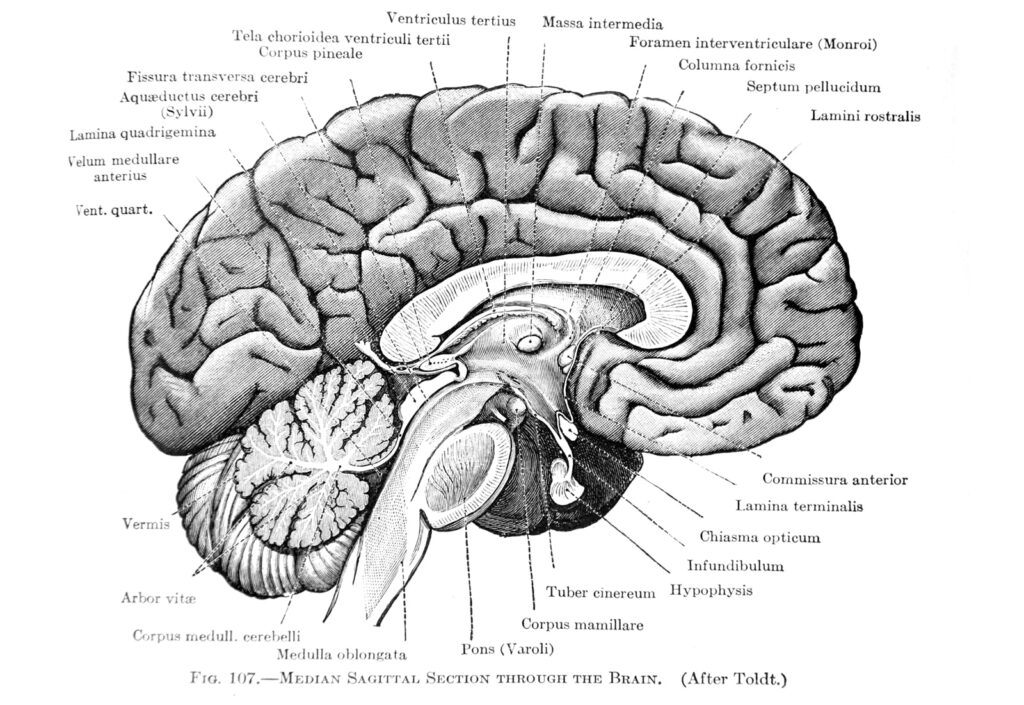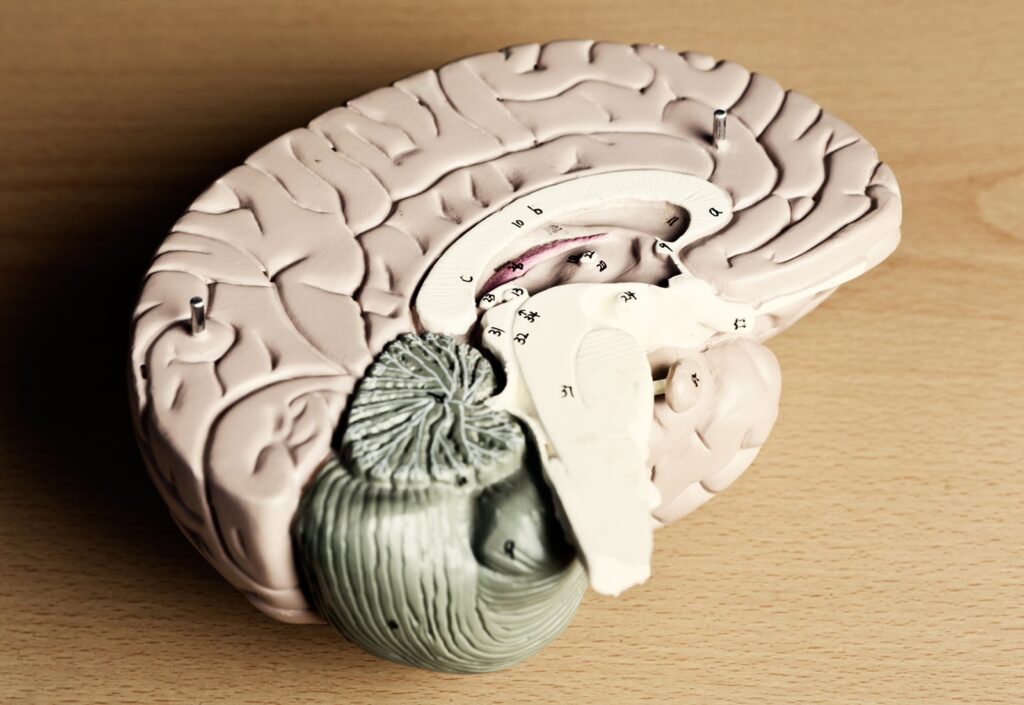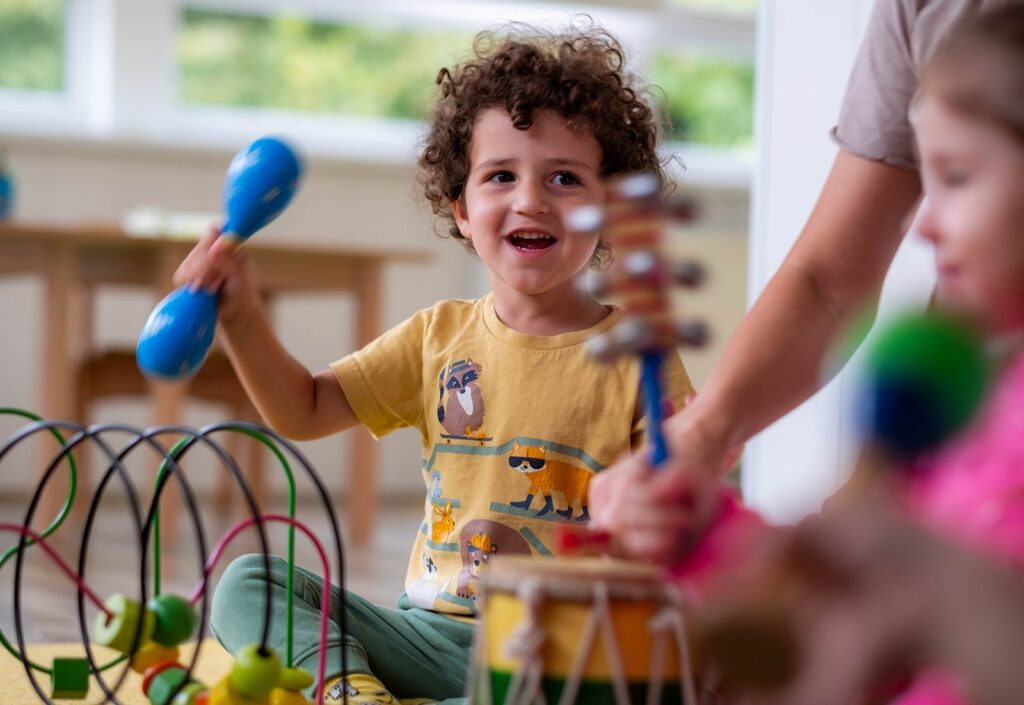How the Brain Combines Sight, Sound, and Movement
The Symphony of the Senses
One candle casts a faint light by flickering alone in an undisturbed room. A nearby violin performs as its music notes hang in the atmosphere. As you run your fingers across the chair’s surface, your brain automatically vividly depicts your environment as bright, sonorous, and detailed. This is multisensory integration.
The human brain achieves an amazing accomplishment with each passing moment. The brain gathers distinct sensory inputs from visual, auditory, tactile, muscular and vestibular systems to construct one unified perception of our reality. Our sensory experiences merge together to create a unified perception of the world. All at once. And more importantly, we understand.
The act of fusion goes beyond mere convenience. It is fundamental. Our mental processes become confused and our movements lose stability when this integration fails. The brain uses multisensory integration to convert chaotic stimuli into coherent experience through an amazing process that remains unseen. Every masterpiece starts with structural elements before reaching its ultimate significance.
This article examines how the brain integrates sight, sound, and movement to create a cohesive experience and explains why this process affects perception as well as developmental and learning aspects and recovery.
The Architecture of Sensory Convergence
The Origins of Sensory Input
The world communicates with us through multiple sensory channels. The eyes take in light through vision which the retina converts into neural signals. Sound waves reach the ears and move as vibrations through the cochlea before transforming into electrical signals directed towards the brain. The body’s ability to sense touch and movement as well as maintain balance stems from specialized sensory receptors found in the skin and muscles together with the vestibular system.
Our sensory organs function as biological detectors which each specialize in recognizing particular types of energy. Photons strike retinal cells. The inner ear contains tiny hairs which sound waves bend. The structure of skin nerve endings changes when pressure and motion are applied to them. The sensory transformations trigger electrical signal cascades which start the perceptual process.
Sensory experiences by themselves lack meaning. A sound is just vibration. Light appears as a flash and photons emerge in a burst. It is during the brain’s interpretive process of shaping patterns and building context that these sensations evolve into experience.
The Meeting of Separate Streams
Although each sensory input starts independently, these signals quickly combine together. The separate sensory pathways start to merge as they travel toward the brain. Sensory pathways behave like braided rivers that combine distinct sensory currents before they reach the higher brain functions.
The intersection between these multiple sensory pathways contains specialized neurons that function as multisensory cells able to process multiple forms of sensory input. The neurons analyze incoming signals by comparing them and combining these inputs to produce evaluations. They ask: Are the flash of light and the sound logically connected? Does the sound of footsteps occur over gravel or another type of surface?
These interactions originate in the brain’s oldest areas such as the brainstem and midbrain before ascending to the level of cortical awareness. The outcome represents an integration that connects data together with meaningful context.
The process is fluid. It adapts as new information enters. Our ability to adapt enables us to operate efficiently in a perpetually changing environment which requires the brain to make rapid decisions about belief while facing uncertainty.
The Rules of Integration
Timing is essential. The brain favors inputs that arrive synchronously. When multiple brain inputs arrive at exactly the same time the brain tends to perceive them as a single event. Congruence in space also matters. When a voice originates from the area where a face appears the brain assigns higher credibility to it. This principle provides us with the ability to move through complicated settings while maintaining flexible yet reliable perception.
Integration extends beyond simple alignment. It is also a matter of relevance. The brain filters what it deems important. The brain focuses first on inputs that either fulfill predicted patterns or present possible dangers. Through multisensory integration the brain enhances its filtering ability to determine both what receives attention and what remains unnoticed.
Our perception emerges from sensory input alongside the influences of attention and memory as well as the underlying principles of probability. The process of integration represents a balancing act that occurs between potential outcomes and established facts as well as between current experiences and previous events.
Unity from Multiplicity
The result is a coherent narrative. The information we perceive comes to us as whole moments enriched with context which we can use to take action. Our perception extends beyond mere sensory input. The nervous system acts as an artist that shapes unity from multiple elements.
This process enables us to navigate through busy traffic safely, engage in dialogue amidst loud environments, and catch objects that drift into our peripheral vision. The invisible structure under instinct enables reflex actions and intuitive responses.
Multisensory integration operates unconsciously in its most fundamental state. It is automatic. Every conscious thought we experience is influenced by its effects. The foundation of awareness lies here where advanced cognitive processes create their images.
It is the brain’s most elegant trick: The brain performs its finest magic when it transforms acoustic disturbances into meaningful data while turning physical sensations into intellectual comprehension.
The Brain’s Integration Centers
Subcortical Pathways: The First Gatekeepers
Subcortical structures process and filter sensory input before it becomes part of conscious thought. The superior colliculus serves as the leading midbrain center which functions as a quick-response node for visual and auditory signals alongside somatosensory input. The brain structure does not understand the world through symbols. It reacts. Swiftly, and often correctly.
The superior colliculus assists the eyes and head in orienting toward unexpected auditory and visual stimuli. This isn’t decision-making—it’s instinct, refined over millennia. But the data it manages isn’t isolated. Multiple sensory signals converge on the superior colliculus which integrates these inputs to determine the most important direction for focus.
The vestibular nuclei located in the brainstem handle the processing of sensory information about balance and movement. The vestibular nuclei function as part of this integration process by determining spatial orientation while working with visual and proprioceptive systems for balance and smooth movement.
The Thalamus and Its Pulvinar Relay
The midbrain frequently sends information to the thalamus. The thalamic pulvinar nucleus plays a crucial role in integrating multiple sensory inputs. The pulvinar acts as a sensory traffic controller by regulating the signals that travel towards the cortex. The system highlights certain elements while minimizing others and organizes them into significant patterns.
According to neuroscientists, the pulvinar performs a crucial function in directing attention and filtering sensory input. The brain selects sensory information that reaches higher cognitive areas which validates the concept that perception filters sensed data to include only what is considered valuable by the brain.
The thalamus functions more as a curator than a messenger by shaping experiential input from numerous possible sources. The system determines which elements enter our conscious awareness.
Cortical Areas: Conscious Awareness Emerges
After its refinement by the thalamus sensory information reaches the cerebral cortex where it undergoes higher-level integration. The posterior parietal cortex within the parietal lobe synthesizes data from visual, tactile, auditory and motor systems to generate spatial awareness and plan movements.
The premotor cortex and superior temporal sulcus represent additional cortical regions that contribute to the process. Here, integration takes on new dimensions: The brain manages to connect sounds with specific faces and emotional memories. The upper cortical layers are where experience develops depth and texture.
These cortical hubs are not isolated processors. These systems establish deep interconnections through networks that dynamically adapt to the ongoing task requirements as well as environmental and internal conditions. This level of multisensory integration enables various complex human activities including conversation and decision-making which forms the basis of our meaningful engagement with the world.
Developmental Origins of Multisensory Processing
Early Wiring in the Infant Brain
The newborn brain starts with some structure but lacks complete functional mapping. Multisensory integration capability exists in the brain but its circuitry remains immature until experience provides input. Newborns show dominant reflex behaviors which begin as single-sense responses before developing into more complex actions.
In the initial months following birth infants develop the ability to connect faces with voices and link movement to sound while recognizing speech rhythms through light and shadow patterns. Infants discover these correlations through repeated exposure over time and do not learn them from direct teaching.
The neural structure of the brain undergoes reconfiguration through learning processes. The brain’s structural changes through synaptic pruning and myelination and the enhancement of multisensory networks stem from initial experiences with the environment. The development process incorporates biological elements alongside experiential factors which direct neural growth according to sensory experiences.
Sensitive Periods and Neural Plasticity
Developmental phases exist where the brain becomes especially open to learning through multiple sensory inputs. The first three years of life provide critical timeframes for establishing fundamental skills in perception, emotional control, and social interaction.
The absence of integration during these developmental periods can result in permanent effects. Early disruptions in multisensory development typically lead to attention deficits as well as coordination challenges in addition to sensory processing difficulties.
Childhood marks only the beginning of the developmental journey. Throughout an individual’s life the brain maintains a degree of plasticity. The proper application of stimuli combined with repetitive practice enables mature brains to reestablish lost neural connections which serves as the core mechanism behind therapies such as OMST.
Foundations for Learning and Behavior
The effective integration of sensory information serves as a fundamental requirement that extends beyond basic movement and balance. The integration of sensory input enables people to acquire language while improving reading skills and understanding social communication along with emotional complexities. Learning functions as an approach to interacting with the world rather than merely acquiring academic skills.
The absence of a unified sensory foundation leads to higher-level cognitive processes becoming dysfunctional. Children who struggle with basic trust in their balance and cannot foresee changes in light or sound intensity need to allocate valuable cognitive resources to maintain self-regulation. There remains minimal capacity for curiosity exploration and expression.
The process of improving multisensory integration expands cognitive abilities which enhances attention span and promotes growth and engagement. The brain requires stability for successful exploration.
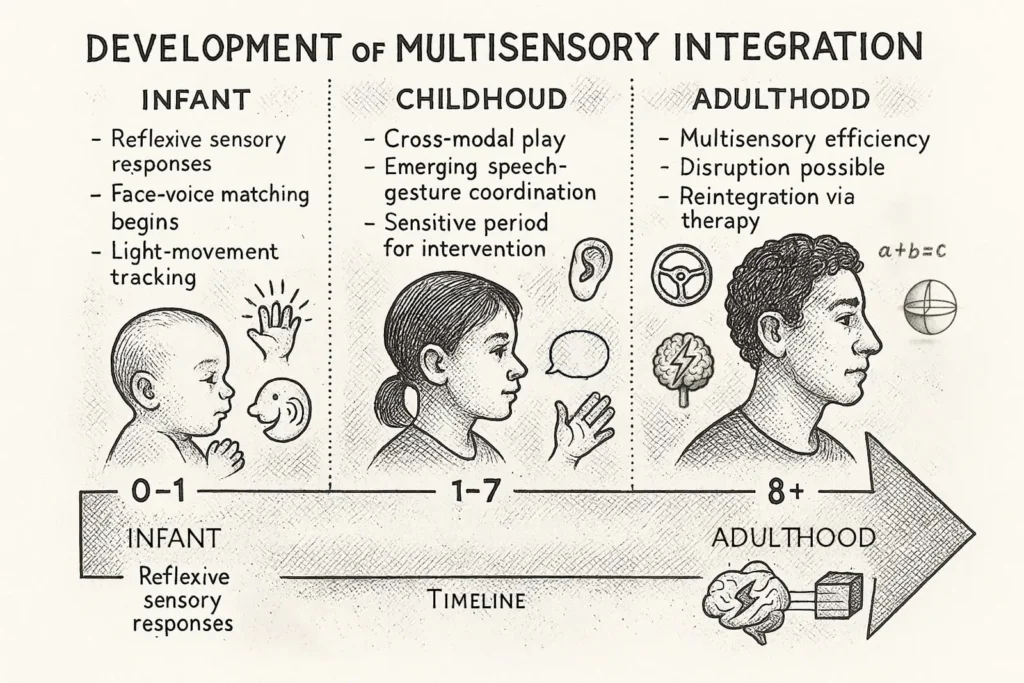
When Integration Fails
The Fragility of Fusion
Multisensory integration is a silent, graceful mechanism. But it is not indestructible. Injury, delay, and disorder can disrupt sensory signal transmission which leads to significant disorganization. The senses keep operating but fail to provide a unified sensory experience. The world starts to break apart and people find themselves struggling to move through it.
People whose integration processes are disrupted often experience feelings of disorientation alongside dizziness and a continual sensation of being out of balance. People with disrupted sensory integration may find basic activities such as entering crowded spaces, reading under artificial lighting, and traveling in vehicles to be excessively stressful. What should be intuitive requires constant vigilance.
Clinical Conditions and Common Signs
Current medical understanding recognizes that multiple conditions stem from disrupted multisensory processing. Patients with mild traumatic brain injuries commonly experience a mismatch between their visual and vestibular systems. Dizziness may arise not from ear damage but from a lack of coordination between visual and balance systems.
The autistic spectrum disorder often features abnormal sensory processing. People experience an overstimulation from bright lighting and sharp noises which disrupts their motor coordination ability. Data reaches the brain but alignment of this information isn’t always possible. People experience their surroundings as unpredictable and hostile environments.
Multiple multisensory symptoms appear in attention disorders as well as developmental delays, PTSD, sensory processing disorder and Long COVID. Though the root causes differ, the outcomes are similar: difficulty filtering, prioritizing, and synchronizing sensory information.
The Cognitive and Emotional Toll
When integration fails, the consequences ripple outward. Performing tasks that used to be simple now demands intentional mental focus. Social interactions become taxing. Emotional regulation is harder to maintain. Children might display behavioral outbursts or withdrawal when this condition emerges. Adults experience fatigue combined with anxiety and diminished confidence when integration fails.
Many people experience the feeling of being trapped in their own bodies while remaining present but feeling disconnected. When sensory unity collapses it affects both the way humans perceive the world and their ability to engage in life’s activities.
Hope in Reorganization
Even though challenges exist, the brain keeps its potential for change. The brain’s ability to change enables gradual reconstruction of damaged pathways connecting sensory areas. Targeted multisensory treatments allow individuals to reconnect fragmented experiences.
Realizing the nature of one’s loss marks the initial phase of recovery. Understanding our situation provides hope which centers not on past restoration but on building a more stable present.
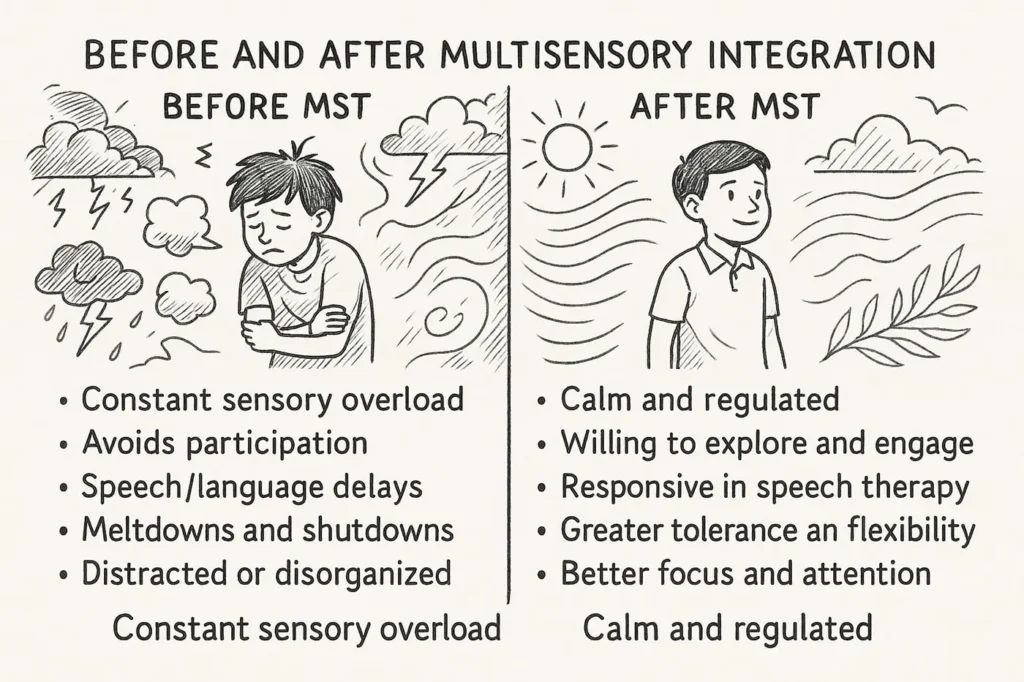
Harmony Restored
A New Path Forward
The recovery process from disrupted multisensory processing does not progress through a straightforward linear path. The process demands dedication along with organized methods and specific types of stimulation. But it is possible. Successfully restoring integration does not depend on willpower but requires inputs that are gentle and multisensory which are delivered in a repetitive manner.
Optometric Multisensory Training (OMST) uses modern techniques to work from the foundational level upward. The approach activates subcortical pathways responsible for early integration while eliminating the need for cognitive effort. Colored light and motion alongside sound and subtle movement merge into patterns that the brain can process and rearrange.
These methods function to assist the system in regaining its previous knowledge rather than replacing existing functions. They nudge, rather than push. And in that subtlety lies their strength.
The Power of Passive Input
Passive therapies provide an effective solution when overstimulation causes problems. OMST enables patients to receive sensory stimuli without requiring interpretation or reaction. It is not about drills or performance. The therapy works by providing the brain with a safe and predictable rhythm to rebuild itself.
The nervous system goes through a relearning process to sort and synchronize sensory inputs while establishing priorities through consistent repetition. Over time, the dissonance softens. The once-jarring signals begin to align.
When sensory harmony is restored life regains balance. The disjointed becomes fluid again. Perception becomes participation.
Beyond Symptoms: Renewed Participation
Restoring multisensory integration goes beyond just reducing symptoms. It is the restoration of capacity. A child who struggled with busy classrooms can now remain seated while actively listening and learning. Adults who previously faced difficulties with driving and work might start to regain mental clarity.
These improvements ripple outward. Small gains lead to larger shifts. Emotional resilience improves. Cognitive bandwidth expands. The world becomes not just navigable—but inviting.
Through renewed participation people can discover their identity emerging once again which is defined by potential instead of disorder.
Integration as a Lifelong Asset
Multisensory processing serves as a continuous foundation rather than just an early developmental milestone. It is a lifelong foundation. Through life’s different phases it enables individuals to grow and learn while healing.
The brain requires integration to work cohesively as one entity throughout infancy recovery and peak performance stages. Nurturing integration strengthens the mind’s capacity to adjust to changes.
Restoration of this state allows one to regain the fundamental peace of existence which acts as the core from which all perception emerges.
Integration as Restoration
A mind that resonates with its senses experiences direct participation in the world rather than just processing it. Multisensory integration functions as a concrete neurological process. The mechanism that connects our experiences to their meanings creates links between perception and memory and connects our presence to our actions.
Life becomes fragmented when the unifying thread becomes worn and damaged. Strengthening this connection through development, recovery or therapy leads to more than just improved function. It is freedom. The freedom to move without dizziness. To listen without strain. To see without overwhelm. To engage without fear.
The fundamental nature of learning and human connection emerges from this integrated approach to input. The story goes beyond multisensory processing. It is the beginning of coherence. The foundation which enables individuals to access the complete spectrum of human experience anew.
In assisting children navigate noisy classroom environments and adults recover from post-concussion symptoms we go beyond brain training. Through our approach we work to restore the brain’s intrinsic wholeness. To feel safe. To move forward with clarity and trust.
